Video
youtube
a “lightning talk” mini-lecture I gave last week
1 note
·
View note
Text
Molly Bounds: Human Kind
via One Good Eye
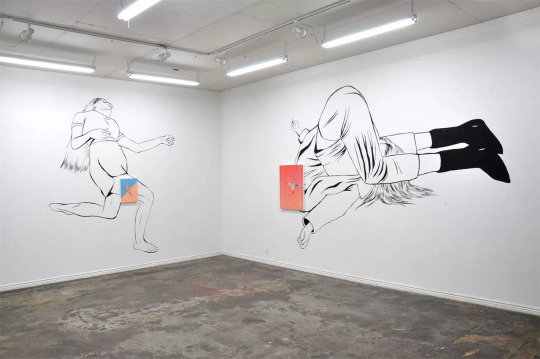
When I came in to Molly Bounds’ studio at RedLine, she was working on a comic for a new local publication dealing with ideas of alternative art education, a topic with deep origins for her. Her parents studied art and wound up as so many art students do, completely resentful of the path they took, and were less than excited about their daughter doing the same. It wasn’t surprising to learn that Molly had a combative relationship with her college professors, rejecting their narrow academic mindset. When she was told not to do something in black-and-white, for example, her response would be, no, fuck you, watch.
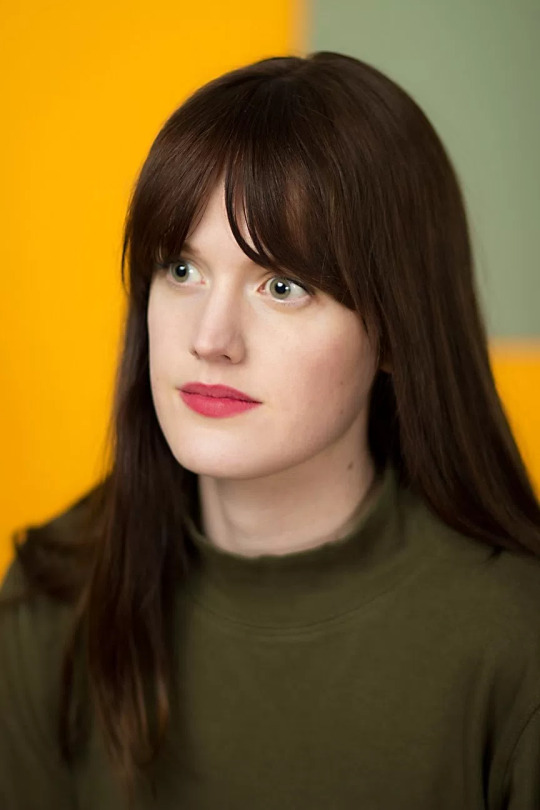
Molly spends a lot of time trying to create work that doesn’t have her name attached to it. So sometime in the past couple years, when people started becoming really interested in the pop color schemes she had been developing, she instantly switched to a subtle, quiet palette. A main tangent of her work has become an investigation into what sort of power she could give those colors, but that agenda could change at any time. This defiant flexibility is why she doesn’t have or want gallery representation.
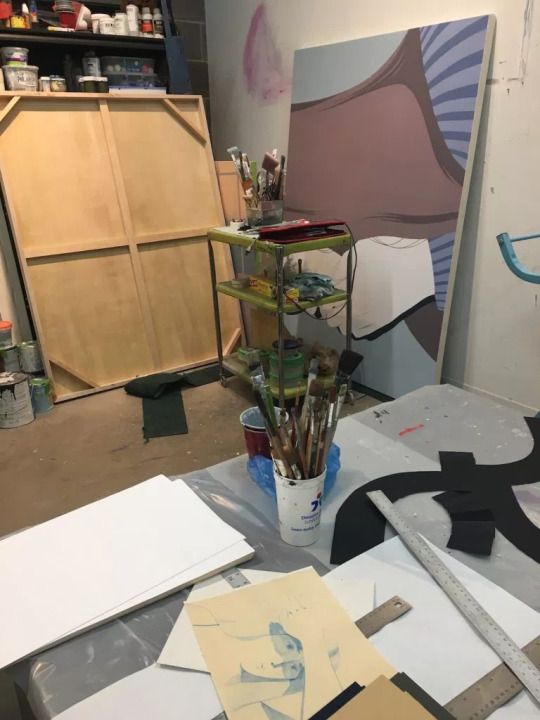
Despite her efforts, though, when I see a Molly Bounds piece, I instantly recognize it. There’s usually this powerfully feminine content, there are characteristic color combinations, sure, but the real signature is this stylized, abstracted flatness with the crystal-clear efficiency of a Lichtenstein.
This flatness comes from her background as a printmaker. After working in a high-profile commercial print shop for awhile out of college, where editions would get scrapped for a single speck of imperfection, one day she looked at her work and couldn’t help but wonder if it had become ‘commercial’. Gross.
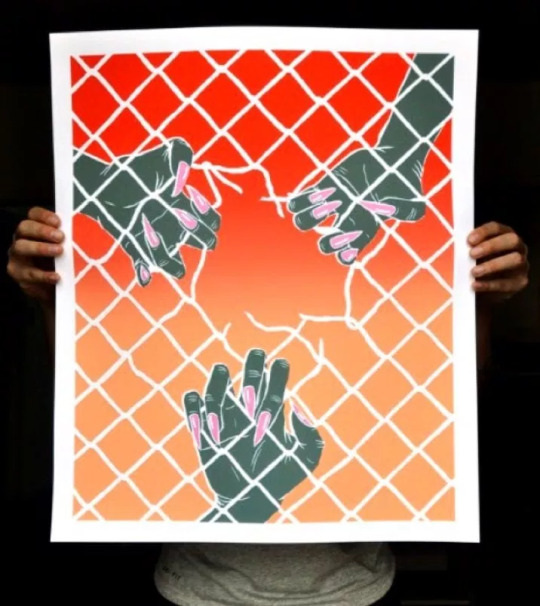
The aesthetics of imperfection were always something she had tried to hone, and she suddenly found herself needing to find a way back to the human hand, which was all but lacking in her native medium. On the side of her printmaking practice, Molly had long been doing murals, and it was the larger scale of these and the looser gesture of the brush that drew her to her current painting practice.

She recalls seeing a David Hockney at SFMOMA, walking up to this monumental painting and noticing these pencil lines, made with the same blue drafting lead as she uses. In that line: the essence of how the thing was started, honesty about that process, an immediate moment of self-realization – you came from the same thread as a master. Coincidentally, my ‘pencil-line’ moment was at a Lichtenstein retro in Chicago. But with the Hockney or the Lichtenstein, those paintings aren’t about those pencil lines, yet they still somehow make the painting their special level of special.

What is it that’s so implacably special about imperfections in art? Is it different to land on imperfections by accident than to seek out their subtle aesthetic? What allows that to work (when it does)? Something contextual about the greater meaning of painting, or art? Or something… You can go deep here, because these are tricky questions, because in a lot of ways their outcome is a fork in the road that leads to either the best or the worst, the most courageous or the laziest, moments in paintings.
In work that is supposed to be so tight and slick and tricky that it belies its creation and it’s about its own craftsmanship, but where the artist let a tape line bleed and maybe they didn’t think someone would notice – that’s the worst shit ever. But what we’re talking about here isn’t that – it’s when maybe like some outlines are cruder than others, whatever – and those elements are embraced as natural parts of a process, incorporated into a stylistic aesthetic. Maybe it’s just an alignment of subjective preferences between Molly and I that make these moments so special, but one of my favorite contemporary painters has long been Neo Rauch, and that’s pretty much the essence of his work, those collisions where something started to stop working and he just left it and moved on to the next moment. It’s this honesty, like, okay, I didn’t really mean to do that but now it’s there. It’s admitting imperfection without the shame of trying to cover it. It’s the majority of what I’m referencing if I was to use the term ‘painterly’.
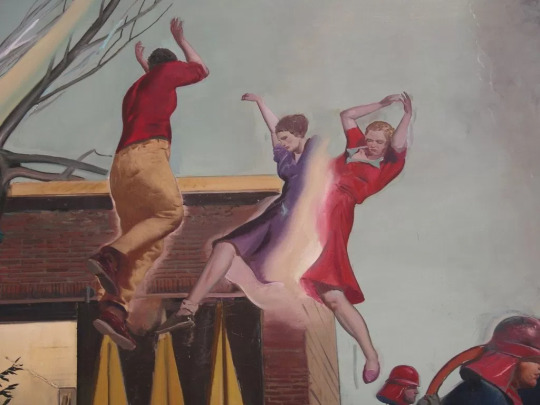
The human element, in this case, embracing vulnerabilities, is characteristic of Molly’s work on many levels. Almost all of her work depicts human figures, and almost all of those figures appear to be grappling with something vaguely familiar to us. There’s an interesting sort of honesty here, where true stories of real people are highly abstracted to their most basic representation. This is where the reductive flatness allows their messages to ring so clearly.

Molly’s reference point here comes from comics. In her personal favorite, Optic Nerve, the story at its core is about an insecure teen girl who passes out at a party and endures an embarrassment no one will let her forget about. It’s interesting to consider how frame cells would be chosen in something like this when there are so few moments of action to pace. As a painter dealing with similar themes and styles, Molly frequently escapes the constraint of having the single frame of a canvas by incorporating her mural work into painting series, hopping outside the picture plane so that the entire room is being read. It’s painting as installation, or vice versa, supposed to be read like a comic you inhabit yourself.
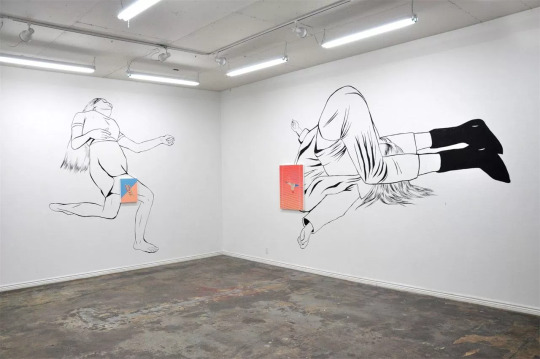
But it isn’t just a coy reference to comics, it’s core to her philosophy about art. It’s the painting version of a zine, of a performance piece: you have to be there to get it. Which isn’t about exclusivity, it’s about a real-life presence. Making sure the art is really there with you in space and time and can’t fully be detached from that context. She wouldn’t recreate the mural in a collector’s house, same as the collector couldn’t keep Yoko Ono in a cage cutting hair.
Molly thinks a lot about performance art. She’s really interested in choreography of the body, particularly using the body in space to enact disruption, like in a protest. Her work is admittedly not very disruptive, but she’s looking to try to enact the same sort of agency within people, a way of finding a voice, finding common ground with others you might’ve assumed you have nothing in common with.
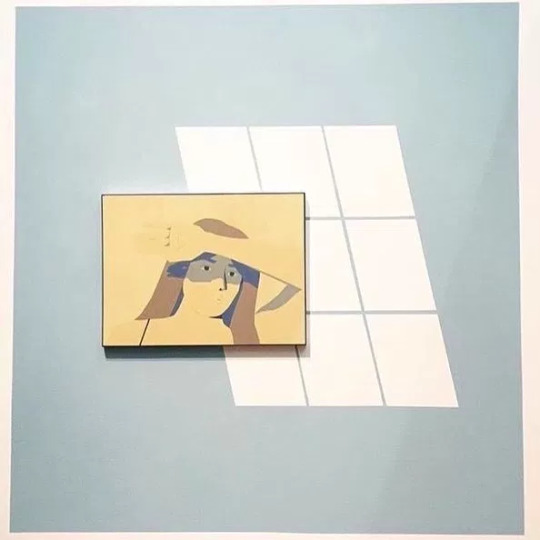
But on the other hand, her works are sort of disruptive to the flow of everyday life, in the same way that meditation is. They’re still and contemplative, and you can reside in their humbly non-intellectual states. The goal is unlocking this quiet thing within ourselves that isn’t even directly translatable to words. And that’s where the earlier conversation about abstracting emotive content is really significant, because emotions are about as abstract as abstract gets. For a by-all-accounts representational painter, dealing successfully and unambiguously with that content is pretty cool.
#Denver#denver art#contemporary art#painting#installation#comics#roy lichtenstein#david hockney#neo rauch#printmaking#illustration
1 note
·
View note
Text
Will Photography Survive Its Art-Historical Karma?
via One Good Eye (Denver)

“I wanted to learn at all costs what Photography was ‘in itself,’ by what essential feature it was to be distinguished from the community of images.”
– Roland Barthes, Camera Lucida, 1980
Month of Photography is just about over, and again, it was a great set of shows, with a diverse array of aesthetics and concepts. But going around and looking at these shows, I can’t help but skew every single one of them with this train of thought, which was at the forefront of my mind even during the last MoP. What I’m talking about is this funny notion that like, what photography did to painting oh-so-many years ago, it’s now suffering itself next to the infinite scrollability of the internet, and as a fine-art discipline is now sort of scampering in painting’s footsteps, conceptually.
Okay, so what do I mean, exactly?
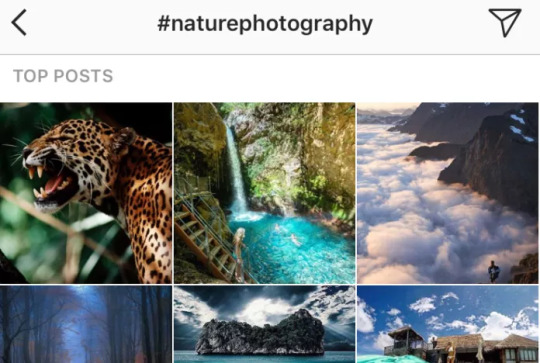
I remember a few years ago suddenly realizing, with everyone talking about how ISIS was using Instagram as their new principal recruitment vehicle, that this was the same Instagram that was in my pocket. Sure enough, a few copy-pasted arabic hashtags (who knows) later, and I was seeing the frontlines of the mythic War On Terror through the eyes of the enemy. Graphic Stuff. Not something many people would want to see, and yes, I definitely worried about the NSA liking my Facebook statuses in the future, but just pause and think about what I’m getting at here. If you can have an experience that shockingly unique on Instagram, an experience also by most accounts not-at-all-Art, where does that leave Photography, the medium of imagery, in its fine-art gallery context? Where does it find meaning anymore?
Without diving too deep into a conversation that is largely played out, this is just so obvious an echo to me of the art-historic birth of the photograph (among other technological revolutions) planting the modernist seeds of conceptual art in painting. Like, ‘okay, well, if we can’t just be images anymore, what can we be?’ Self-reference begets itself.
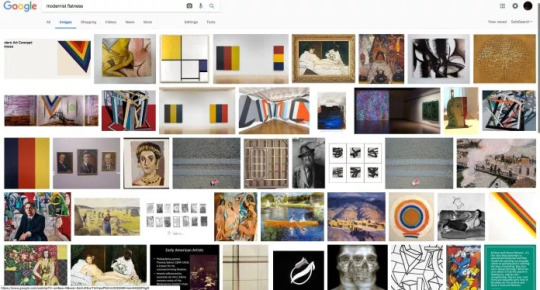
Today, it’s likewise the case that photographs in a gallery rarely seem to hold up merely by the merit of their imagery. Some do, sure. But as a whole, how much of the representative body of MoP 2017 were ‘just photos’, vs. how much seemed to raise the question of the taxonomical boundaries of Photography? Coincidence?
It’s interesting because much of the best work that was ‘purely photographic’ seemed to reference its own flatness (see: the sort of iconic moment of painting’s departure from photography, denying the illusionistic depth of the picture plane and calling attention to itself as an object). Take, for example, Michael Borek’s really wonderful series in the entry alcove of Redline’s Between the Medium, in which various immediately identifiable landmarks suddenly ‘freeze’ flat as you notice that they’re just photos of photos of the landmarks, applied as vinyl to the sides of buses or some other sort of metal industrially-paneled surfaces. These defining, contrasty fissures in the images’ surfaces carve their own space up like a Mondrian, referencing the perpendicular edges of the picture plane. The fact that multiple images wind up in a single frame in this body of work only further adds to the feeling that these things are really about themselves being viewed.
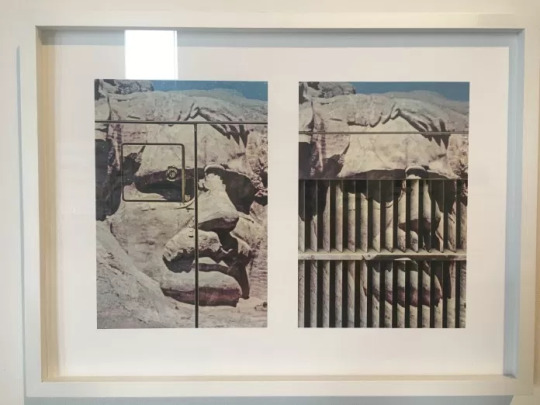
Even further down the line of the ‘Expanded Field’ trajectory of painterly dialogue, another really exceptional body of work belongs to George Perez at Alto’s Denver Collage Club group show. Stacks of home photos with their centers carved out, like tunnels through remembrance of a vacation or something, are curled from being wrapped tightly in rubber bands. They become objects, almost. At least more than they would simply as a stack of images, which would read as a presentation strategy more than a state of being. The tension in their form, though, sort of snaps you out of viewing their content, and all you can pay attention to is the density of them together, in the room. There’s something very real and here-and-now that happens from this – it’s what Rauschenberg was seeking, on a humble scale.

This ‘in the room’ feeling seems to be one of the most prevalent trends for Month of Photography shows this year, in one way or another. At Leon’s Skins, Tya Alisa Anthony sheds the frames from her images, letting the prints ripple in the air conditioning, the texture of the images breathing the same air as us, getting us all the closer to the skin of her models, the face-value subject of the show.

A similar sort of relationship-to-the-body occurs in the best pieces at CVA’s Presence: Reflections on the Middle East, a series in which the ornately decorated windshields and interiors of various public transit buses fill the frame, life-sized, allowing us to sort of sit directly in front of these things, contemplating them as stand-in portraits of who might be driving them. You feel empathy for the ghost of the driver purely for the sake that you could almost step in there. Tableau-vivants.

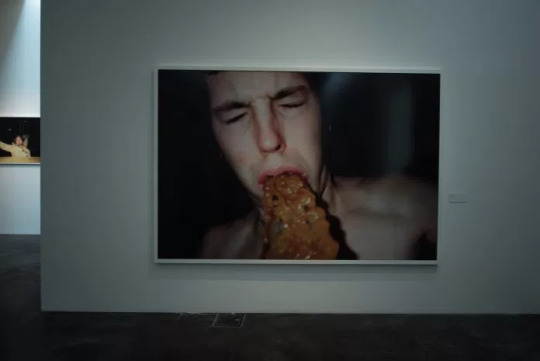
I mean, I’ll admit, I’m definitely putting a spin on all of this, framing all this work this way. I’m biased, I’m a painter. But let’s take a step back from the as-painting conversation, and talk about MCA’s Ryan McGinley retro. Here is an utterly ‘just photo’ show, and what’s more, it’s totally the kind of thing that you would see on the internet. But where the show is interesting is that it’s there in physical space with you. It’s the fact that an art museum is willing to put blowjobs, pissing, coke-sniffing, and projectile-vomiting on their walls, larger than life. The difference between a computer screen and an art museum was really driven home here when a circa-eight-year-old girl ran ahead of her parents into the porniest room of the exhibition as I was leaving.
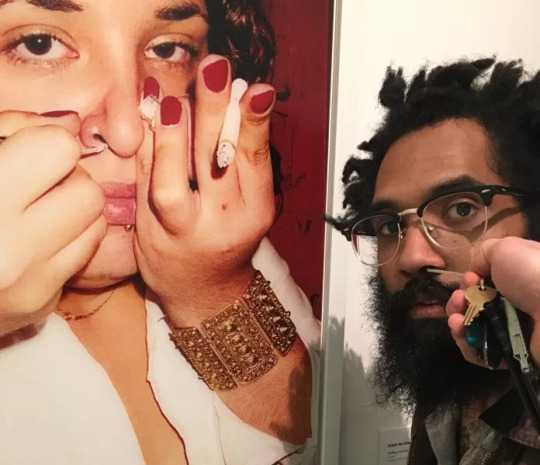
The most successful show this past month, in my opinion, was David B Smith’s Penelope Umbrico solo, because it really brought all of the things I’ve mentioned together in a dialogue that felt very nuanced and high-level. At first glance, it’s certainly the most painterly show, with large, manipulated images in various forms of prints and frames, repetitiously referencing fluorescence in various ways. As well as themselves, rather explicitly. But from the serial, tiled arrangements, even overlapping, of the photos, to the most resonant moments – rows of polaroids of lens flares and fireworks, hung just high enough so that the track lighting reflects into your eyes, the show is about the entire thing together, there, in the room. Which is why the way that these polaroids, sparklingly activated by their surroundings, are so much more interesting than the superficially similar arrangement of McGinley’s at MCA. When I asked a gallery attendant if Umbrico always made photography, I got the response that photography was her subject, not necessarily her medium. Nice.

Plenty of these shows had politically or otherwise relevant content, but let’s face it, none of them really dug into anything in a way more significant than what you’d get from a few seconds of googling their themes on your phone. There’s plenty to say about various work that was successful that I didn’t touch on, as well, sure. But at the end of the day, the only work that really felt like it was alive and thriving and not just there because it’s the biennial was the work that was aware of itself. Maybe aware of its own mortality. Which is where I go back to my original point — that the ‘aura’, the ineffable thing that was supposedly the last stand of painting in the face of photography, may be all that photography has left to set its fine-art status aside from the unending stream of images we see every day.
“Even the most perfect reproduction … is lacking in one element: its presence in time and space, its unique existence at the place where it happens to be.”
–Walter Benjamin, Work of Art in the Age of Mechanical Reproduction, 1936
2 notes
·
View notes
Text
Dmitri Obergfell: Death of the Cool
via One Good Eye (Denver)
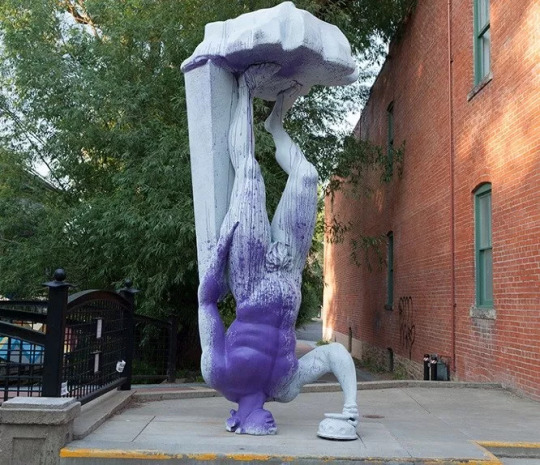
INTRO:
This is the first of a series of experimental writings about, and in collaboration with, select Denver artists. Having no specific agenda other than an interest in these artists’ work, the plan is to have a conversation with them in their studio about whatever happens to come up. There’s no Q&A, no topics to necessarily cover, and honestly, if there’s one thing I want from these experiments, it’s for them to feel different than your typical artist interview. A conversation that is true to the work and the personalities of the artists and myself.
I hope to document the personality of the conversation itself. So keeping the process organic beyond their studio and back into my own, the writing produced will inherit the thematic trajectory of the dialogue directly, with my role as writer being to subsume both peoples’ viewpoints, conclusions, questions, answers, misdirections, etc., into a single, weirdly tangential perspective.
DMITRI OBERGFELL: THE DEATH OF THE COOL

Dmitri Obergfell’s process fills the entire main space of Leisure Gallery, his current studio, in preparation for his show, Man is a Bubble and Time Is a Place, opening at Gildar Gallery March 23. Rap music from Macbook speakers echoes around our conversation. The entire time I was in there, he never paused from making molds. I started in at the natural place: What’s this show about?
Basically, it’s a meditation on “Deep Time” — an idea sampled from 2001: A Space Odyssey (the book), in which one of the most defining moments was the first time a proto-human got bored. Thus began the search for meaning, leading to the creation of symbols, the original “victory over time” that allowed information to be passed to future generations. But this sounds romantic, which isn’t the point. Dmitri is mainly just curious about what might possibly in the future be considered an artifact representative of our current era of massive overproduction.

Really, though, think about what this might be in our current, pop culture-obsessed world. The commodity of what we might call Cool? It’s certainly what’s being produced in rap and pop music, and just about every other corner of cultural industry other than art (as artists would love you to think — but really, their Cool is a commodity too, just more codified).

This has always resonated in Obergfell’s art for me, even at surface value, reflected in the chameleon paint signature to his style. The “flip paint,” as it’s sometimes known, which changes color under varying light conditions, embodies the theme of change and originally came from his fascination with car modification culture, where people have this eerily invested relationship with objects. Weirdly similar to Egyptian funerary art — some of the most extraordinary artworks ever produced, with express intent to be immediately put in the ground. I’ve personally felt for most of my life that the purpose of capital-A-Art is easiest to grasp in a sarcophagus. And I know it isn’t just Obergfell and myself who are on this wavelength: it was one of the most beautiful themes in Matthew Barney’s largely grueling film-opera, River of Fundament, screened in town as an arrival present from DAM curator Becky Hart not too long ago.
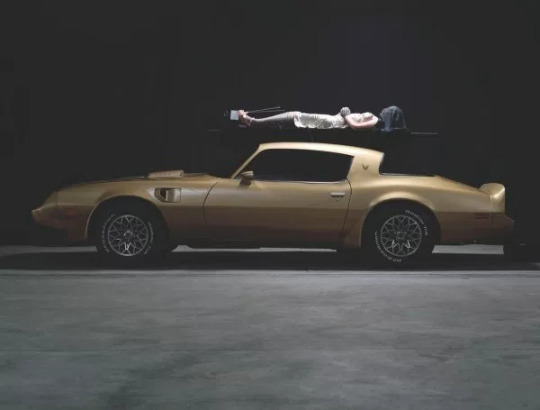
But really, for the majority of history, most art arguably had to do with some spiritual notion of death, all the way up until it made a departure from Christianity and began a slow descent into a sort of crisis as it began to become increasingly about only itself. Some might even say that modernism was a result of art becoming aware of its own mortality, with abstraction and minimalism and postmodern schools of self-referentiality becoming obsessively anxious about their encroaching deaths.

That’s a bit pessimistic, though, which is a sort of inapplicable frame for pieces like Dmitri’s recent installation featured in DAM’s Mi Tierra, which reads as not only profoundly Cool, in its chrome-plated, flip-painted, nails-did, speaker-boxed, narco-saint-swearing, tequila-shot-taking visual vocabulary, but also heartfelt, detail-oriented, and really very fresh and futuristic. Obergfell brings up Robert Smithson saying something like, “installation isn’t about filling up a room, it’s about taking things out.” This aside, though, perhaps one of the greatest strengths of this piece is that it isn’t art-about-art. It feels like it’s made for non-artists to enjoy — a product of the MTV / internet age, not just in its references, but in its attenuation to short attention spans with dozens of layered, individual moments for viewers to explore with reward at their leisure. To thumb through like the window shoppers we all are, until the museum revokes the public’s entry privileges because we can’t stop ourselves from doing so (true story).
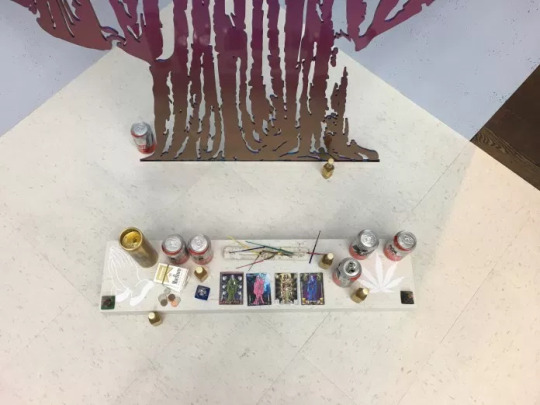
The fact that Dmitri’s works can be understood and appreciated by both artists and those who know nothing about art cannot be emphasized enough. His artworks’ brand of Cool is that of common symbology, things cool to regular people, in some ways analogous to really exceptionally-produced radio-rap. There’s a persistent legibility, even if you don’t know the prerequisite slang (artSpeak) to understand everything being said. And this is really important to him, mainly because art is in a really dangerous place in our current political climate. Much of the public may come to (if they don’t already) view being an artist as some sort of con, and regardless of any individual cases of subjective truth to that effect, it’s a fact that art is at least threatened by more forms of recreation and entertainment than ever before, constantly competing for increasingly shorter attention spans.
It’s true, sadly. The magic that often lived in art — in Stonehenge, in representational painting, in philosophical minimalism — where is it now? Because mystery, wonder, and “how the hell?” often feel like they now belong to software. And while art has always progressed in tandem with technology, is it a given that, as just one of many incarnations of information, it’s exempt from an expiration date?
This all leads me to the place where I don’t think what might be an “average” perspective on art misses the point at all. If art has this anxiety about its own death, which it compensates for by incessantly semantically proving it’s existential value in this core way, perpetuated by an industry where accumulating generations of post-Duchampian, self-proclaimed Artists successively come-of-age wanting to believe that the fortune they spent on their art-school education was worthwhile — okay, it’s a big ‘if’, but if that’s true — it kinda makes sense that artists wouldn’t want to just make “some shit that’s cool”. But whether tastes are fabricated by capitalism or not, whether that matters or not, “some cool shit” is what anyone who isn’t plagued by these anxieties wants art to be. And even just within the context of a museum visit, focusing on anything in the 21st century is like speed-dating.
Art shouldn’t be superficial. It honestly probably isn’t even art if it doesn’t get deeper and better the longer you spend with it. But it should be gratifying and appreciative of its viewership now more than ever. In a political time when it could be said that people are increasingly scared of being challenged, in all areas of their lives, whether thanks to Facebook algorithms or just some greater zeitgeist, what I’m getting at is a dangerous line of thought, for sure. But I think taking seriously people’s willingness to engage information will only benefit the future of art’s wider efficacy, and maybe ensure it even has that future in the first place. It’s important to connect to the culture you’re a part of, not just simply detach from or criticize it. Then influence is possible. Enjoyment will always be capitalized upon. That doesn’t mean it should be taken for granted.

Returning to 2001 (the movie) — which anecdotally is my personal favorite work of art — no one understood this better than Stanley Kubrick. His movies are immaculately shot. Basically perfect. But if you really think about it, what he did was almost like what people now call “edutainment,” a sort of high-art sacrilege. And yet, there’s no doubt that the way he works with the “material” of film, using something shiny to draw people into his world of ideas, is tactically smart, to say the least. I personally don’t mind admitting that I love to be edutained.
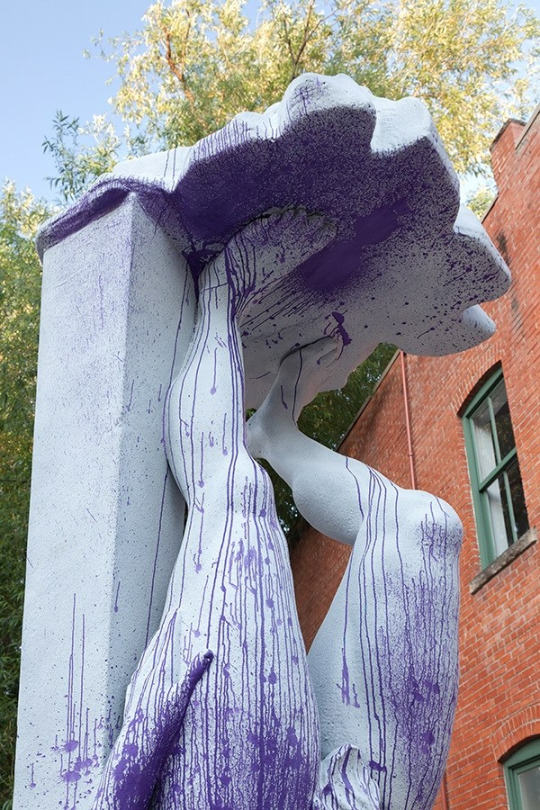
I wanted to talk about Obergfell’s sculpture at BMOCA, Go Home Bacchus, which seemed much farther down the continuum toward “critical” art, and learned that I kinda missed the mark in my interpretation. It’s not institutional critique, it’s again, a meditation. On monuments. They’re everywhere — huge, politically charged objects made by bureaucracies to celebrate victory, a kind of weird idea in the post-9/11 world, you might think, but apparently these sorts of idealistic, fascist colossuses are still a major export of North Korea for dictators worldwide. When New Orleans takes down their confederate monuments, as in current news, then how best to do that? Will they literally topple them? What an indulgent symbol…
And yet, for all this power these things are supposed to hold in the public spaces they reign over, its almost like the only way for people to react is to take a selfie in front of them, or else commit petty vandalism. It’s almost like instinctual in our culture, like it’s funny to vandalize a giant statue whether you care about the politics behind it or not.
youtube
Obergfell’s main piece of research for this project was the scene in Tim Burton’s Batman when Jack Nicholson’s Joker brings his gang in to supervillianize the art museum. “A really fucking cool scene,” representative of popular culture. But then also around that time ISIS began making headlines for destroying vast amounts of historical artifacts — horrifically seeming to say “we’re erasing your history in its most prized form, it’s gone, we own you.” So it turns out there is power in the act…
youtube
But Bacchus is about graffiti, not aesthetic genocide. But maybe not even graffiti, because that word is loaded and this has nothing to do with geometric, gradient murals. So a more slippery concept — slippery to the extent that Obergfell *might* not even be upset if someone was to tag the piece. Something racist: no-go. Some self-important graffiti writer trying to claim the piece and “get up” — get out. Junior WestSideMafia alternative school student? Go for it. The person who keeps writing “Kill Trump” on electrical boxes around Denver, please. Do your thing (endorsement is mine, not necessarily the artist’s).

Not to get redundant, but there’s something really charmingly normal about the shit-headed vibe of these sentiments, likened by Dmitri to a teenager stealing fire extinguishers to blow at cars in the parking lot for fun. And while that’s so juvenile and condemnable by the ultra-ethical art world, I know – is it not also kind of the most raw manifestation of The Artist’s Instinct, if such a thing exists? To just say “fuck it I’m gonna do this thing and see what happens”.
Why? “I just thought it’d be cool.”
#contemporary art#gildar#dmitri obergfell#installation#cool#sculpture#kubrick#deep time#graffiti#matthew barney#flip paint#chameleon paint#symbols#dam
0 notes
Text
new things to come
not going to give away any secrets, but there’s some exciting stuff on the horizon for my art-writing
*-)
0 notes
Text
Behind the Fourth Wall: My Experience as a Museum Worker

It’s a unique experience, art-handling – being a “preparator” (which autocorrect thinks isn’t real). Like with any manual labor, it’s rad to get paid to work out. But obviously, there’s much more to it than that. You touch the untouchable things, you have keys to rooms many will never know exist full of objects to be seen by sometimes even fewer (I mean, the amount of pictures on my computer I wanted to include in this post and just...couldn’t...for whatever reason...it’s more than just a couple), and you live behind the fourth wall that is the magic of the completed exhibition. You built the wall. And in a way, it’s like there’s some of yourself sealed in there.

There’s a sort of trivial glory in it, but also a kind of hilarious demystification, a rapid desensitization to the wondrous. And a lot of the most menial labor you could possibly imagine. Dozens and dozens of hours of out-of-body audiobooking while waxing-on/off. I haven’t been doing it long enough to become jaded yet, but I know very few career preparators it hasn’t happened to. But really, would I be writing this if I didn’t think it was awesome?
I’ve had a lot of people over the years ask me how I came to do work like this, so I want to give that question a bit of attention:
I had an internship and then a job at a gallery in college, the H&R Block Artspace – which was run by a really brilliant director and showed world-class art, but mostly entailed sitting at a desk and socializing with visitors. But toward its end, I met some real-live art-handlers who chuckled with sympathy when I tried to get on with them. That small private company very shortly after, however, got the contract for several years of building traveling exhibits from New York’s American Museum of Natural History at a brand new nature and science museum outside Kansas City. And they needed a big team all of a sudden, and gave me a call. So I started out building dinosaurs.

There’s a very ad-hoc feeling to that sort of context. You need this thing to fit with that thing and if you’re tool-savvy enough, you make it happen. Sometimes it’s not pretty but if it’s safe to let the public walk under then it will work. It’s fun, or at least engaging – the small-scope part of the job which is just the constant problem-solving and spontaneous fabrication strategies.

But the bigger picture that fascinated me from the beginning about this kind of work was the collision of information and architecture. This is what will always carry over into my future pursuits: the question of, how do you best craft an architectural space, one inhabited momentarily by all varieties of people, the sole purpose of which is to educate each of those people about some element of culture in an engaging way?
I got my taste, but quickly realized that it’s incredibly hard to make a living in this career path. The nature of art-world work is that almost all positions are contract, meaning you need a minimum of probably 2-3 jobs at once to juggle in order to make it work, and still often there are dead periods where you are really panic-level strapped for cash. So I branched out quickly in as many relevant directions as I could, taking any skill-building entry-level job I could find. Some of the paths I took were fabrication-oriented: doing backend assembly of custom commercial cabinetry, then finish work on museum casework and artists’ sculptures. Some were art-handling: private transport and storage, hanging galleries, assisting professional artists on installs, etc. There’s a resume on my website *eye roll*.
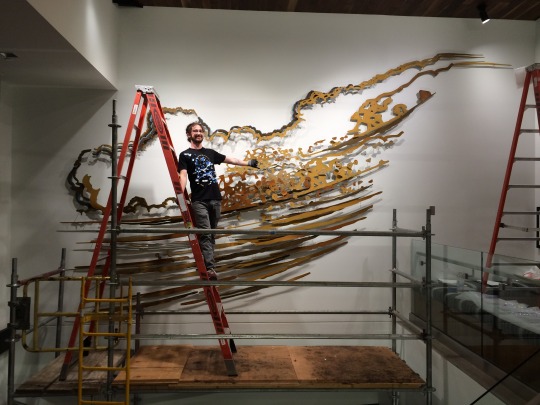
Every one of these jobs I gained through face-to-face ‘networking’, through someone I met at another gig. Meaning at the recommendation of friends. Most of them I worked with my best friend, also Will, who got me into the world of art museums. Team Will, shoutout.

I’ve in turn gotten more than a couple of people their first museum jobs. There’s nowhere I’ve seen where ‘who you know’ matters more.
That being said, not everyone is cut out for it. Most aren’t. I just happen to associate with generally exceptional people ^______^ . It takes an eye for a ridiculous level of detail, and a hand that can consistently perform tasks attuned to that detail without fucking anything up. Plus snap-judgment problem solving skills for often dangerous and/or costly predicaments. You also generally need to be a fun person, since the work can get quite tense (understatement for the 60hr/wk installs my team is used to) and it helps to be able to lighten things up.

It’s interesting how many different skillsets and attitudes intersect in this world. You have very blue-collar-flavored work surrounded by typically intellectual types of people. The stakes are high (put it in the back of your mind that just about every individual object around you is worth more than you might ever make in your life, accumulated) so people are very serious, especially around art, and while there’s a special level of hero-ness in actually touching The Stuff, it can tend to involve less creativity, for good reason. I was a Lego kid, so the construction and space-creation side of the job was always a little more engaging for me, personally.

So I really lucked out to land where I’m at today at the Denver Art Museum. My current job is basically to assist in the construction, fabrication, assembly, and finishing of everything that exists between the empty room and the art. It’s called “Exhibitions Production”, and at DAM, what a ‘production’ it is. We do really high-dollar build-outs designed to be theatrically jaw-dropping to the public. At standards of craft that I’ve never seen anywhere else as ‘standard’ – think 1/16″ margins on nearly everything. Which, combined with the irregularly angled Liebeskind building we do most of our work in, makes my job pretty complicated. Which keeps me out of trouble, which is nice.

So back to how the hell I landed in such a good one:
In order to secure this job (they’re extremely coveted and basically impossible to get without personal invitation), I had to work as a guard, a ‘gallery host’, for half a year. I told my hiring managers in that interview that I only wanted the job to meet the art-handlers who I would be working for in the future. It was interesting to take a step back from the behind-the-scenes world I was used to and be basically at ground-level with the visitors, an underling of the museum social hierarchy who exists as a mediator of rules. By interesting I mean almost totally shitty, with the exception of a much slower-paced experience of observing many, many people engaging the same exhibits day after day. I had always worked to put the shows on, but by the time that is over with you are sick of the show and already on to the next thing anyways. Catharsis. This was sort of the opposite – like a Groundhog Day of visitors forever wiping their oily foreheads all over the fourth wall. Incident Report.
But it offered an opportunity to see both sides of the idea of ‘the exhibition’. The before and after. To watch people’s patterns of real-live interaction with shows that clearly had intricate thought put into specifically the visitor-engagement / education elements of their designs.
And it also worked: it gave me the opportunity to see someone pushing a cart full of tools, whose boss’s email I got from him, who I proceeded to harass frequently over the next half a year until he finally agreed to give me a trial run.
Since my promotion to the Exhibitions department, moving on to work with the designers and administrators in charge of those experiences I mentioned – that has been so fulfilling. It’s been the best job I’ve ever had, but beyond just enjoyable day-to-day-ness, it planted the seed that has grown into my biggest fascination now, which is the idea of the future of the museum experience.
“Museum Experience Design” – the museum in the digital age. Information architecture meets architecture. Rather than didactics for a universal audience, a modal, entirely custom veil of educational opportunity tailored to each visitor... That kind of thing. That’s where I’m headed. But that’s an entirely different topic.
For now I just feel super lucky to be on such a ridiculously talented team at a big, well-funded museum that puts on such extravagant shows. There’s a lot to observe, and a lot to learn.
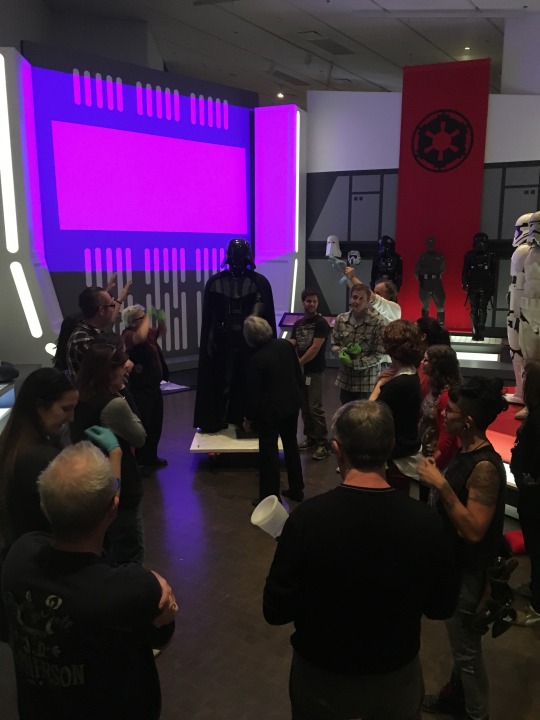
I guess the moral of the story, if there is one, is that if you really want to get into this kind of work, you need to be talented, i.e. probably an artist (no, not a conceptual artist), but mainly you need to put yourself out there and meet the people who can hire you. And be relentless in trying to get them to do it. There aren’t a lot of these jobs but they’re worth trying to get.
If you land one, just make sure you don’t drop anything, then have fun.
1 note
·
View note
Text
on workspace: extension of the brain
So I’m currently taking some classes from the Interaction Design Foundation on Design Thinking, and a lesson today was talking about physical creative space. Which is something I have talked several times at length about with my buddy Eden, fellow life-artist and the owner of Five Points Pizza. On a handout for a craftsmanship workshop Eden led, the very first point was: 1) MASTERY OF YOUR ENVIRONMENT (Production): “Production ultimately defines the product.” I couldn’t agree more.
The studio space for me, and I would say for all artists, is so important to take seriously. As a freshman in college, my first teacher frequently would make us clean up our entire workflow, rearrange tables, find new neighbors, and take out different supplies. I went on to study Painting, the major lucky enough to offer the most personal real estate for the tuition (many people joked that’s why you choose the department). As a senior, for my first project I built a two-story loft-style studio within, up, out of my cubicle – a fort, I called it – and made art about forts in it all year.
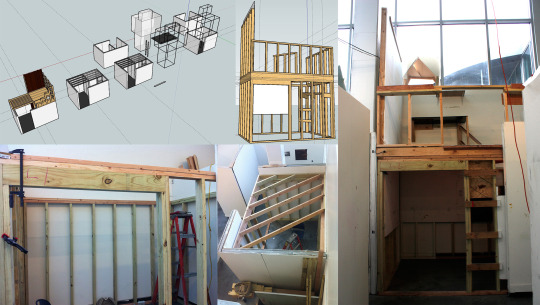
After graduating, I attempted renovate my leaky, freezing KC garage before deciding, fuck all that, but was luckily shortly after granted an excessive office-style studio space for writing in downtown KC through the Charlotte Street Foundation.


Then I had the opposite of a studio for about half a year and traveled cross-country on a motorcycle, worked on a farm without electricity or warm water in California, and couch-surfed while working various museum jobs. No personal space whatsoever. But lots of time to think.
But life brought me to Denver for a steady job, and here we arrive at what I really wanted to write about. I moved March of 2015 into a one-bedroom low-income apartment with the intent of living in it like a studio apartment with an art studio attached. Over the last two years, I’ve rearranged the dynamic of this space probably a half dozen times, and luckily for this occasion, documented most of the iterations. Here’s what it looked like when I first moved in, all starry eyed:

I basically had some furniture, and I fit it all in as sensibly as I could. Rough draft. All of the flat tabletop space was great, because as I got my practice rolling again, I was working on dozens of handheld-size oil/glass sculptures and needed lots of room to spread out the assembly process. Ultimately, the walls were really under-used and I got rid of the large table, which was a good move because suddenly life shit happened and I found myself needing a roommate to cover rent.
This was the most challenging point in making the studio space work, obviously, because I had two rooms worth of shit I needed to make fit in one. But with the help of Sketchup and Vyvanse, I made a plan:
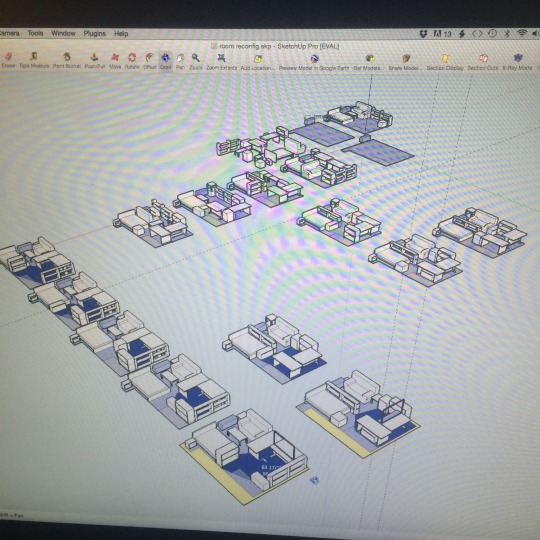
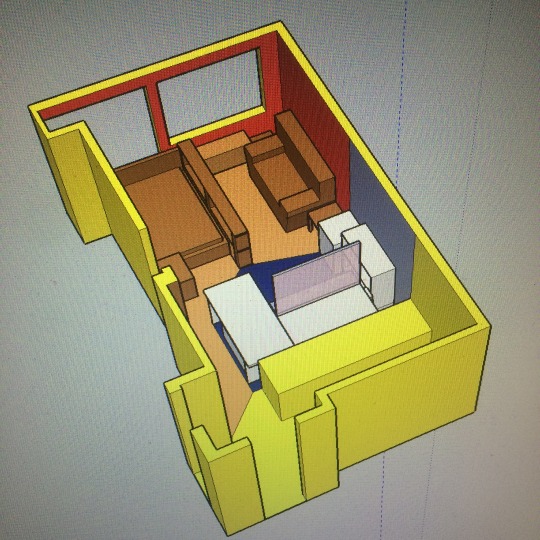
And it worked.
It was super crucial to me to preserve a division between live- and work-space. Even though I had just one room I spent pretty much all my time in, I had psychological boundaries indicated physically, like with the canvas on the floor, that reminded me, this space is for working.


And it did actually work, because as my workspace changed out of necessity, my workflow followed suit. I made a series of smallish wall-hung paintings on glass, all about the size of the surfaces I had to work on, extending from what I had been learning from the previous studio mode. The rapid switching of gears spatially meant I had to really grasp on to some conceptual material somehow, which led me to make a few mindmaps, which ultimately turned into that series of paintings.
But luckily the situation wasn’t permanent, and just as my process was starting to outgrow its small container, the roommate moved and I had my bedroom back. Differently this time.

Immediately the work began to change. An old college painting came down off the kitchen wall to be painted over, more than twice the size of the largest piece I had been working on out in my living room. And soon another 2x3′ canvas followed, and the smaller series of works began to stack up. I inherited some trapezoidal pedestals from work, and those found their way in there too for a short time. They’re clunky as all hell, so that was short-lived. They make nice end-tables.
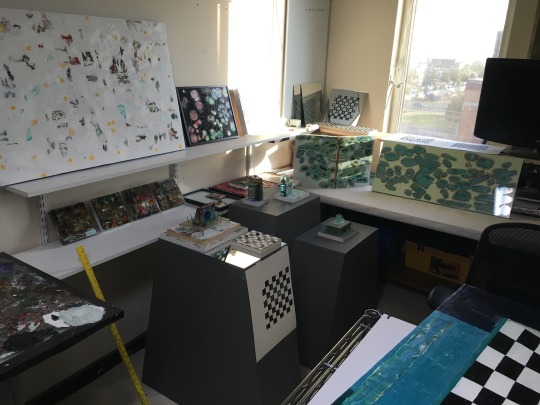
And the more I painted, the more wall space was necessary.
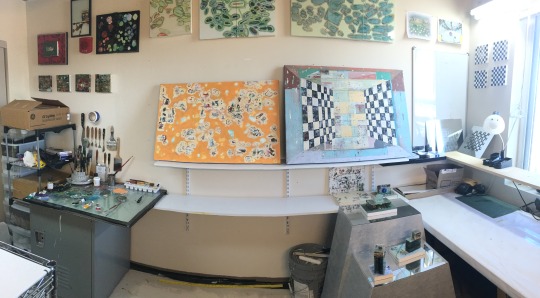
And then this happened.
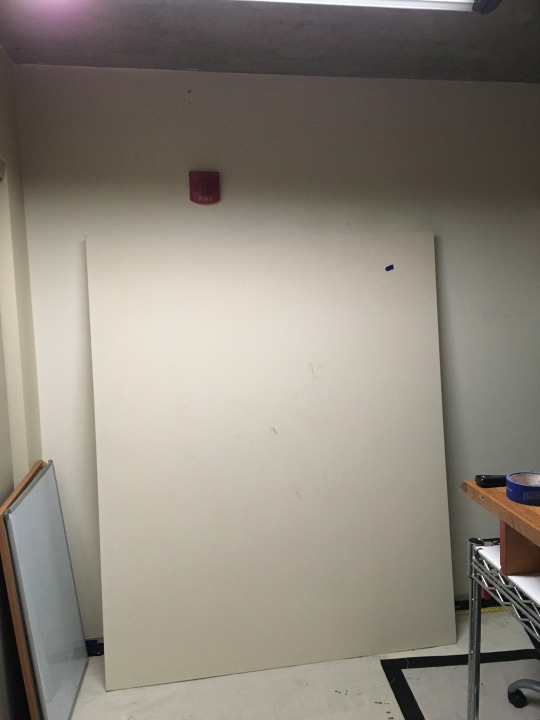
And then this. Those are each about 5x6′, which doesn’t seem huge until you put them in a bedroom.

Shit. All of a sudden I was a painter again, I guess, after a long time of being too art-schooled-out to accept such a thing. And the entire studio needed to change to accommodate that role.

As I painted more and more, I realized that my other future-minded tech pursuits (don’t worry about that here) were only a distraction to have in the same space. And I needed more walls. So another shift.
Maximum wall space in the studio for painting, with shelving available for the smaller painting-sculptures to still be possible, with palette and shelving on casters to make for a modular configuration. I even took the door off the hinges. I took this photo today:

All this left my live-space looking like:
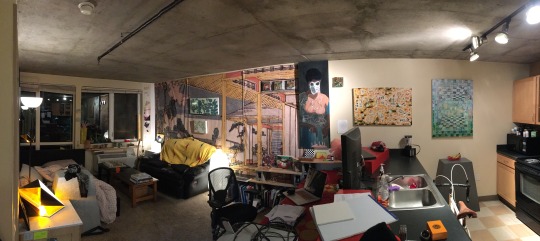
You can see the two finished ~2x3′ pieces I was mentioning on the right. One of them is on my website.
The main room is split between a more personal/social back area and a still separate workspace for digital/non-messy creative pursuits.
Like this here.
I wonder if I would’ve even written this had I not moved my computer out here...
I thought maybe I would have some more overarching truths about *the workspace as a physical brain* to offer, but maybe all that is just contingent on your personal whole deal. Maybe the moral of the story is to be aware of the way your studio space influences your work and vice-versa. I’ll defer to Eden for the zen wisdom:
PRODUCTION ULTIMATELY DEFINES THE PRODUCT
If nothing else, this should be a nice little intimate glimpse into my process.
Rambly, but hey. Getting back in the flow. <3
0 notes
Text
long time no see
Hi there internet,
It’s been a long couple of years full of changes and growth and etc. Yadada yada.
One of the revelations that’s come to me, clearly, is that long-form essay-type writing (for free) is not a sustainable part of my creative practice, at least as of now. But the absence of writing from my practice entirely aside from personal journaling has left a void. What a conundrum...
So from here on, I’m going to try to keep a more frequently updated series of sort of informal blog posts about various things I’ve been thinking about. They might relate to my visual studio practice, or to thoughts that have been lingering around more persistently. Who knows. But the words need to start flowing again.
See you soon,
Will
0 notes
Text
Star Wars Wars: a Contemporary Cubist Masterpiece
Been awhile since there was something that I really wanted to write about, but for this one I couldn’t resist...
Star Wars Wars: a Contemporary Cubist Masterpiece

A couple weeks ago, I stumbled upon an intriguingly titled article on Esquire: All 6 Star Wars Movies Playing at the Same Time is Art, Man. Okay, sure. I clicked. The author actually went on to make a compelling case, citing the film theory of renowned animator Stan Brakhage. It was enough to convince me to sit down for the two and a half hour ride. The majority of that time spent mouth-agape, after finishing YouTube user maurc’s fan video, Star Wars Wars: All 6 Films at Once, I’ll not only agree with the Esquire author, but I will raise him that I think the video is not only art, but a contemporary cubist masterpiece.
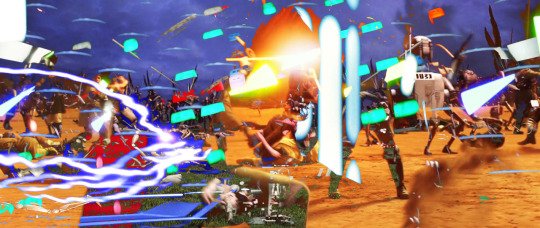
I’d go as far as to say that Star Wars Wars is even more Star-Wars-y than the original–which is sort of an unfair comparison considering the fundamental difference between a six-segment cohesive narrative saga and a sensorily cacophonous fireworks show of special effects. But that’s the key to appreciating maurc’s work – you have to let it wash over you as a one-of-a-kind aesthetic experience, allowing a vague sense of meaning to flow toward and away from you, lapping at your desire to understand. The overall narrative theme of the saga is still there, albeit vibrating in a sort of beautiful metaphoric sense – the yin and yang of the meditatively consistent battle embodied by the struggle of the Jedi against the Dark Side. We’re just more intensely immersed in the thick of it here. Furthermore, Star Wars Wars seems much Far-Farther away, for all its six-track alien language and only partially contiguous plot logic, than its anglophonic source material.
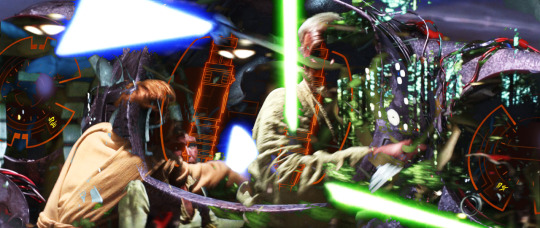
Hinted at subtly in the Esquire article is that Star Wars Wars is extremely heavy on the psychedelic vibe. I won’t dance around it – this video feels the most like watching a movie on LSD than anything short of the authentic experience could be expected to. Which factor honestly contributes to the whole alien element more than any other. After all, both the alien and the psychedelic are each defined by a reckoning with a foreign Force. The constant chaos of six intervals of a story remixed and overlain leads to a sort of choose-your-own-adventure scenario where ‘meaning’ is constantly redefined from one moment to the next. This is only possible due to the source material being composed of such an identifiable palette of plot points from the archive of cultural media memory.
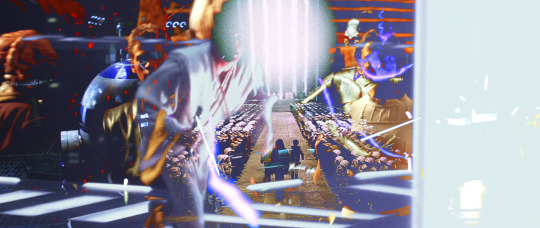
And a palette is really the way to think about the ‘movie’ in this art piece, because far more than cinema, this is a painting using as pigment the phenomenal special effects that have for decades drawn viewers of all ages to Lucasfilm. The sort of (actual) painting to which I would draw an analogy is the sort of abstractionism that evolved out of a cubist tradition – many moments of material colliding on a canvas – like the works of contemporary painter Eric Sall (coincidentally currently at a residency in Roswell...). Had he the chance, Picasso would certainly have loved to paint with lightsabers.
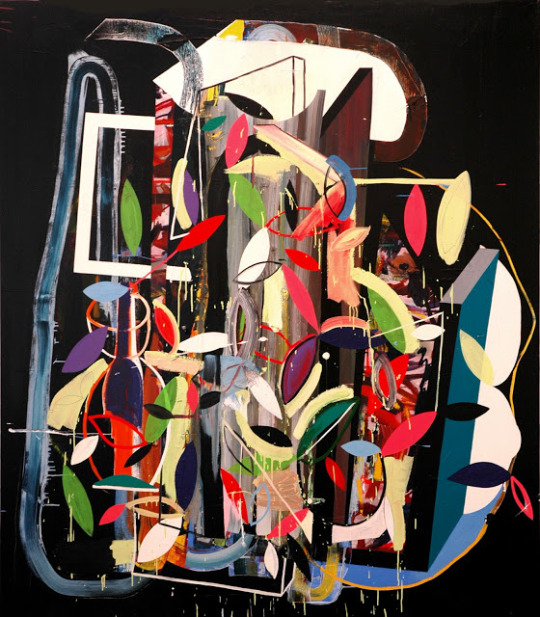

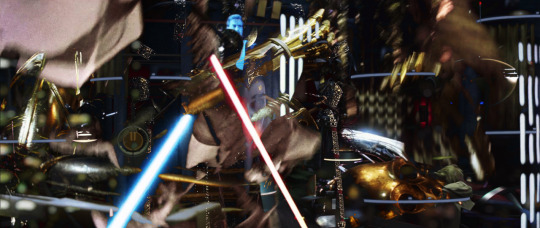
To talk about this work as a painting, though, might be somewhat misleading, because what it really is, non-metaphorically, is a collage. The role that collage has played in the history of cubism is primarily to allow for a representation of the fourth-dimension – time – by showing a subject in many states of existence at once. Fascinatingly, when collage is performed with time-based media, as in Christian Marclay’s The Clock (which won the first-place Golden Lion at the 51st Venice Biennale in 2011) time isn't just referenced, it's actually used. Go figure. And the temporal 4D is of the utmost importance when talking about a series of films with which production of the second half preceded the first by decades, with which the third word of the entire story is Time. Star Wars is one long out-of-order progression from good to evil and back. To further shuffle the causality, as a cultural artifact of fan art, is actually quite the appropriate cubistic homage to the original.
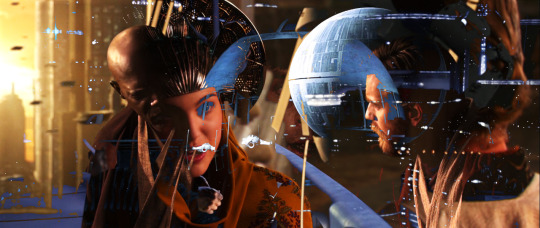
I’ve been dreaming for some time of this vague notion of a way that a cubist sensibility might manifest in the digital arts. If the cinematic window is thought of as analogous to the picture-planes of 2D static images, what would it look like if spatial-reality contradictions coexisted in an illusionistic temporal-reality? Exactly like Star Wars Wars, which is why I am so enthusiastic in asserting its significance. Picasso wanted a guitar that was somehow more guitar than the guitar itself–so I wonder again, is it possible that maurc’s piece is more Star Wars than the original?
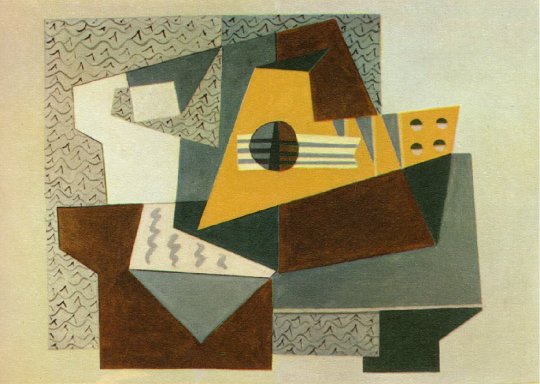
all images credit user maurcs imgur except Picassos (credit arthistoryarchive.com and wikiart.org) and Sall (credit ericsallpaintings.blogspot.com)
#Star Wars#star wars wars#cubism#psychedelic#lsd#trippy#collage#video art#painting#abstractionism#eric sall#picasso#guitar#special effects#SFX#stan brakhage#contemporary art#fan art#maurcs#youtube#art writing#art#lightsabers#christian marclay#clock#roswell#aliens
3 notes
·
View notes
Text
-----division-----
all of the writing below this post was done as part of the 2013-2014 Charlotte Street Foundation Urban Culture Project Studio Writing Residency Program.
0 notes
Text
PIX
Thanks to everyone who came out to the solo show of my 'Paintings' series at the Writers Place on August First Fridays! Had a really great time with the ~75 people who came through. If you missed it, Writers Place hrs are something like 11-3 weekdays and the show will be up through most of September.
The official statement for work in the show below:
What’s the difference between reading and seeing? Ever get distracted from a book and realize you are three pages ahead of the last thing you remember? Why is it so much more difficult to drink with our friends while enjoying a text than doing the same with a painting? Is it possible to float around, in and out of writing leisurely like we do with images?
You’re driving and you see the road. You see grass and trees and birds and telephone lines and a hotel at the next left. You know it’s a hotel and not a motel because you read it. When your brain realizes it’s looking at text, some mechanism whirs into action that allows you to see something somewhere past the typeface. That bird is always that bird.
You’re at an art show looking at an artful figure ground relationship framed on a wall. But looking in these frames, it’s obvious this stuff is actually writing, too, and it’s kinda…
Around here is when that hotel mechanism whirs on. I’m interested in these Paintings as controlled vehicles to engage that phenomenon. The shifting of mental gears.
Writers have readings, which are awesome, but at these the social activity is listening, not reading. Reading along with people is something that generally isn’t done unless you have a group of committedly nerdy friends with a ton of free time.
Ultimately, phenomenology aside, I really want to make writing that people can have a drunken social experience with. That’s why I made Paintings. Pix.
-
A couple of images from the show:
My favorite piece of new work in the show, Portrait of Mother Nature Lookin So Fine (Daamn), 2014. A landscape in the form of a portrait:
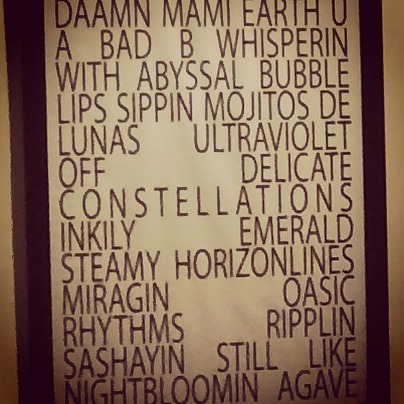
A wide shot of layout: (photo courtesy Writers Place)
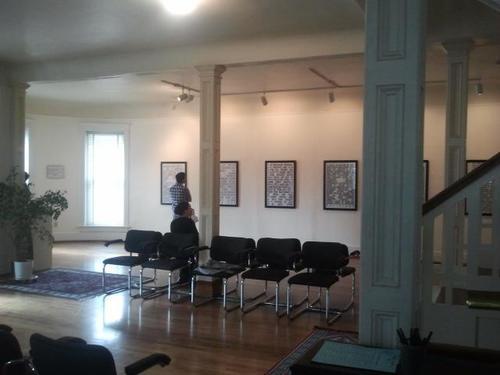
Proski #1 enjoying printed Paintings: (photo courtesy the homie Will Toni)

Proski #2 enjoying new written Painting. All editing (only additive) contingent on picture plane confines: (also courtesy Wip Toner)

Other friends and acquaintances getting drunk to some writing... Success!: (Wip)
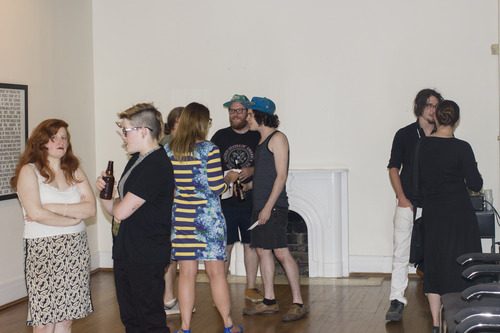
-
All in all, such a great way to wrap up my time here in Kansas City. Thanks to Jose Faus and the Writers Place for setting me up with the opportunity. Asta luego folks.
This will probably be my last post for quite awhile.
<3 Will
#kansas city art#art writing#text art#text#text paintings#image text#painting#word paintings#word art#writers place#kansas city#will meier#willmeierart
2 notes
·
View notes
Text
Here are some shots of new work in my UCP studio:
installation:
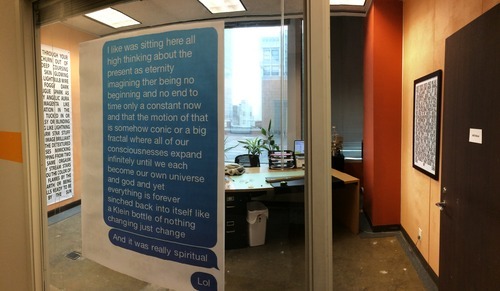
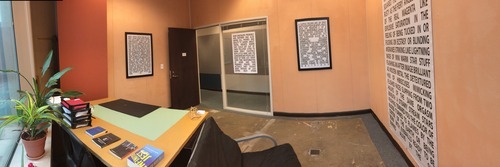
more:
Portrait of Myself with Bad Manners:
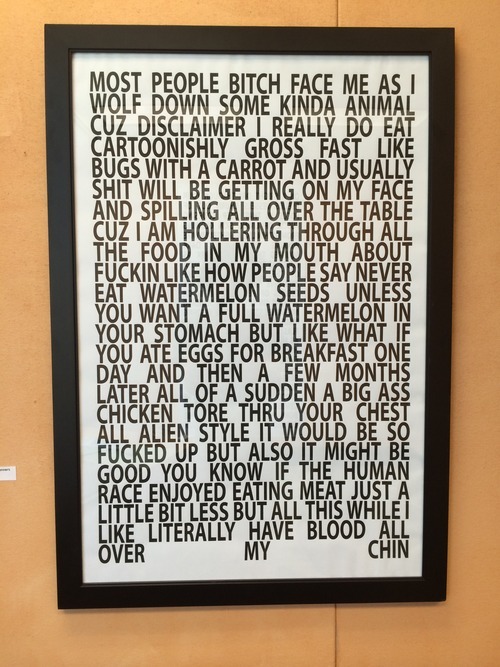
Portrait of Myself Daydreaming:

Painting of My Favorite Color (photo courtesy EG Schempf):
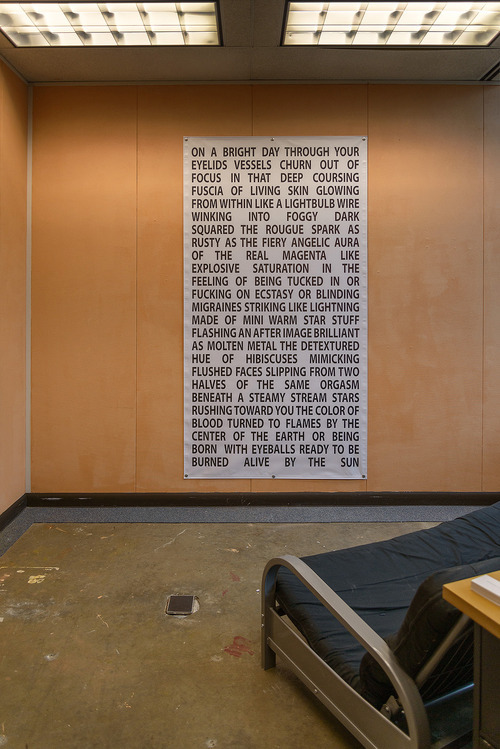
Painting of My Favorite Color installed on my front porch at 41st & Warwick:
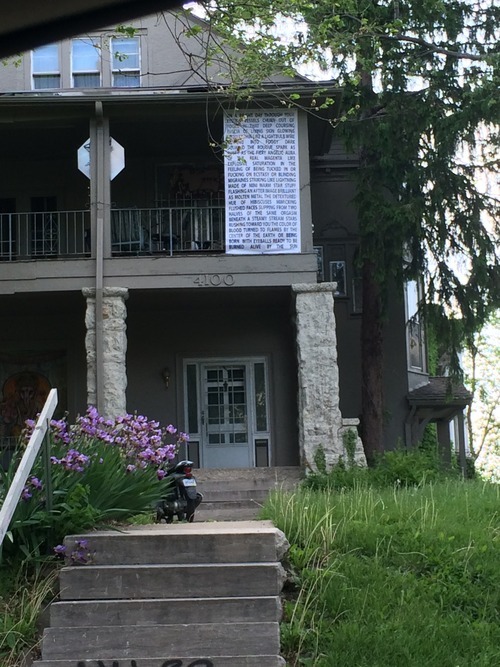
so I've been switching up the arts-writing for art-writing lately...
more to come soon.
6 notes
·
View notes
Text
Moebius Strip (Bad at Sports)

A little late posting this, but great news:
I was asked to contribute an article for February to the Chicago-based art blog, Bad at Sports, giving an idea of what is going on in the Kansas City art scene currently. My contribution takes six shows, all from January 2014, and discusses how they form a conceptual Moebius strip of the "correlation between pictures of things and picturesque things."
This is the first time my writing has been featured in a major, non-KC publication, so I'm extremely excited. Check it out!
#bad at sports#will meier#kansas city art#art writing#arts-writing#city ice arts#miles neidinger#objet#dean roper#weed craft#charlotte street#urban culture project#paragraph gallery#digital art#tumblr art#sculpture#solo show#group show#moebius strip#moebius#mobius#kansas city#contemporary art#painting#rapid prototyping#ceramics#contemporary ceramics#joey watson#dope on a rope#jennifer wilkinson
2 notes
·
View notes
Text
Fictional Futures: Scott Dickson's We Are Not This Body at PLUG Projects
Fictional Futures: Scott Dickson’s We Are Not This Body at PLUG Projects

We Are Not This Body, an exhibition of some 60 small collaged works by Scott Dickson on view at PLUG Projects through the end of February ’14, wishes you were here at its dreamy sites and sights from yesteryear’s futuristic, utopian technopolises.
Most immediately and pervasively striking about Dickson’s postcards? “They’re kinda perfect, aren’t they,” a local arts matron commented. Dickson’s process involves precisely inlaying a positive shape into a negative void, resulting in matte, holographic, pebbled, and gloss glacial planes incised with the fault-lines of their editorial history. They’re more like jigsaw puzzles than mosaics or photos simply glued on top of each other.
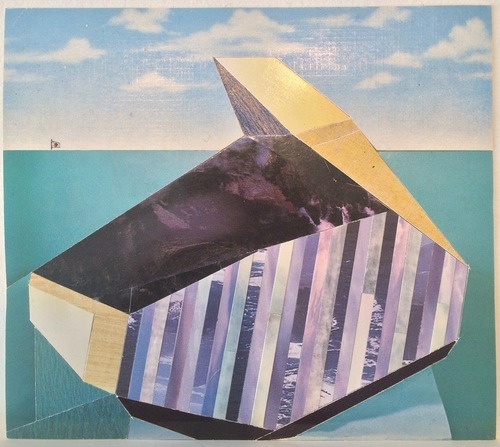
What makes them so alluring is their “clutch-power” – a phrase that comes from the way two LEGO bricks perfectly snap together, coined by a CEO discussing the brand’s market success. While structural soundness is LEGO’s game, Dickson’s clutch-power is primarily aesthetic: the appearance that the pieces of his pieces were put together just right. If you can take the door of craft for granted, it opens to more interesting conversations.
The retro vibe of the postcards’ materials and rendering comes from the past, but Dickson’s aesthetic sensibility points to the future. Using the word with a capital-F in ten of his titles, he means the kind dreamt of in the past by people like Hanna-Barberra’s Jetsons. So there is this paradox of time as Dickson looks to the past as a mirror in which he sees over his shoulder into the beyond.

If I were a sci-fi publisher, I would be all over Dickson’s images, because great book covers exhibit iconic yet obscure emblems of the narrative they wrap around. Conversely, Dickson’s pictures imply events larger than their perimeter’s peripheries, like all good short stories. Imagine the pinkish glow of Emanating Monolith, Monument to The Other, or the most obvious example in the room, Future Formation, Pulpit Contact, matched to a sci-fi epic…

For example: both Philip K Dick’s Valis (1981) and 2001: A Space Odyssey (1969) achieve their peculiar sense of disjointed, vivid surreality through their centering of the literary (or alternately filmic, to switch things up in the case of the latter) lens around inanimate or otherwise imaginary essences. Like the way that Dick’s talking, multiple universes of time, his alter-ego Horselover Fat, his mysterious pink lightning seem insane and unreal unless directly in the narrative lens, Kubrick’s epic involves the transformation of antagonistic-forces into -agents. There’s obviously HAL, but the most important thing-come-alive is the cosmic Rothkoid obelisk, which drives essentially every movement in plot across space and time. Others have pointed out that the monolith is “a highly expressive film device that functions as an emblem, more than as an artifact, of the Mystery Beyond … [in its] anthropomorphic geometry” (Thomas Allen Nelson, Kubrick: Inside a Film Artist’s Maze, 2000, p.118). Imagine Future Formation, Pulpit Contact as A Space Odyssey – standing austerely, glinting coldly, while playing the monumental first notes of its siren song, Thus Spake Zarathustra, on the keys of its tailfin synthesizer.
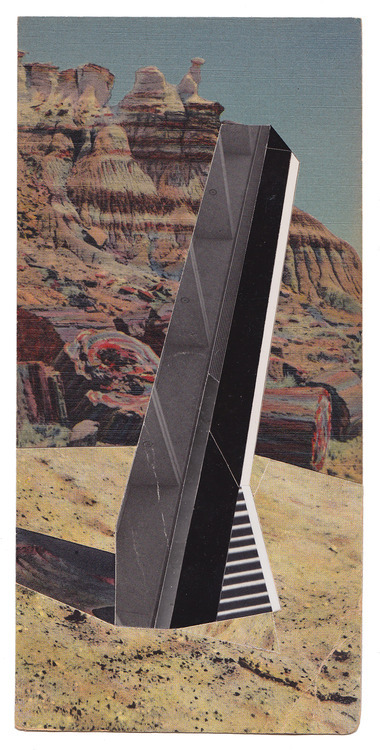
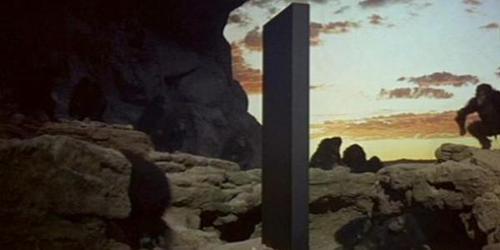
Over half of the 56 pieces in We Are Not This Body use the word monument in their title. From the great pyramids to the Statue of Liberty, monuments are icons of the culture they represent, things given profound symbolic importance. That’s why they’re on postcards. They’re iconic. In their sacred, art-historical origins, icons signified a higher power who would be otherwise everywhere and thus nowhere in particular.
It’s no coincidence that in alternate denotation, icons float as tiny images encapsulating objects of desire in the relatively uniform chaos of the computer-screenscape. And is scrolling through a stream of near-identically sized icons in a monitor really all that different than perusing the 47 works resting on sleek shelves in the PLUG space?


Funny. For work that seems so adamantly not about the computer in its mode of analogue fauxtoshop, its layered compositional organization roils in the undercurrent of a picture-in-picture psyche. Like PKD���s ancient Rome superimposed over 60’s California. Specifically, anytime there is a remotely rectilinear section of the picture plane with a different spatial structure than its surroundings, that quadrant becomes in effect a screen or window within another into which we can peer – a phenomena that is only underscored by Dickson’s making use of seductively specular materials that glint with neon luminescence.
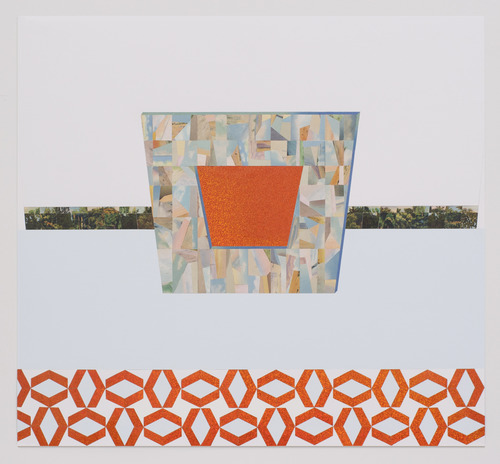
Think about the difference between landscape and landscaping, like the edge between nature and a garden. This is both the collage of curating and the curation in collage. And like topiary, where cutting something out is sort of alchemical, Dickson’s collated fragments enable the hallucinatory leap into the depths of fiction that is one of art’s greatest gifts to the conscious observer. Yes, that’s right, sci-fi means fantasy in the realm of images, where your wildest dreams can come true.
But if this is about objects of fantasy, then what about the pieces that just have plain old open space? Although some consider nature romantically, I think in this show there is something else going on. We are never allowed a landscape alone, because at the very least there is some sort of framing device built into the image so that it is always just that: an image of an image of a landscape. In Dickson’s world we only see our nature through a proxy.
Let’s end in the sci-fi spirit. Imagine it’s a futuristic society long after Mother Earth has died. Technically, she’s sort of more like in a coma. We, humans, killed her, obviously, but we’re also sort of keeping her on life support and holding on as best we can. The details aren’t important, it’s pretty much the same sort of scenario as E M Forster’s ‘The Machine Stops’, from the serendipitously titled collection The Eternal Moment (1909). But what makes our story unique is that now, images of the natural world, whether holograms or Old Masters landscapes, are sacred and mythic and everyone’s total fascination, and they’re basically everywhere now that they somehow actually matter again to contemporary art/social critics, to the extent that the human presence in visual art is not only lame but offensive and so anytime an artist wants to represent a persona of some sort they have to do it via an inanimate proxy. Like a screen. Or art.
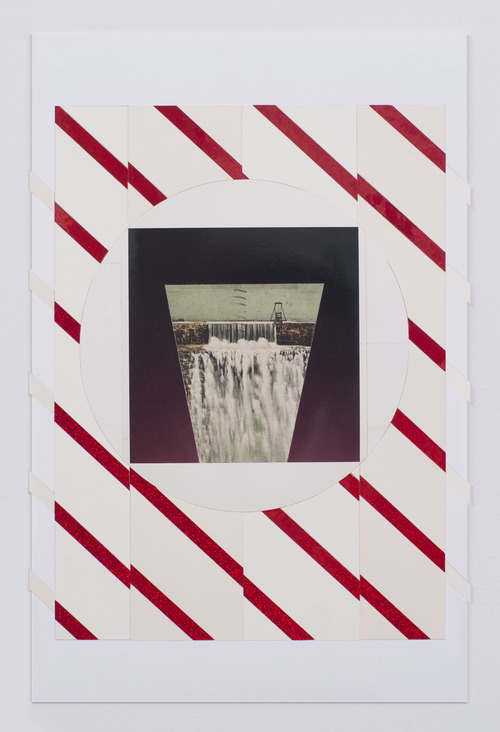
#review#fiction#sci-fi#scott dickson#Plug Projects#solo show#kansas city art#will meier#jetsons#2001: a space odyssey#kubrick#philip k dick#pkd#valis#clutch-power#lego#collage#images#illusion#fantasy#the future#timelessness#eternalism#monument#icon#alchemy#computers#digital space#digital psychology#compositional psychology
4 notes
·
View notes
Text
read this: a story of waveform nested tapestries and hallucinatory seizures
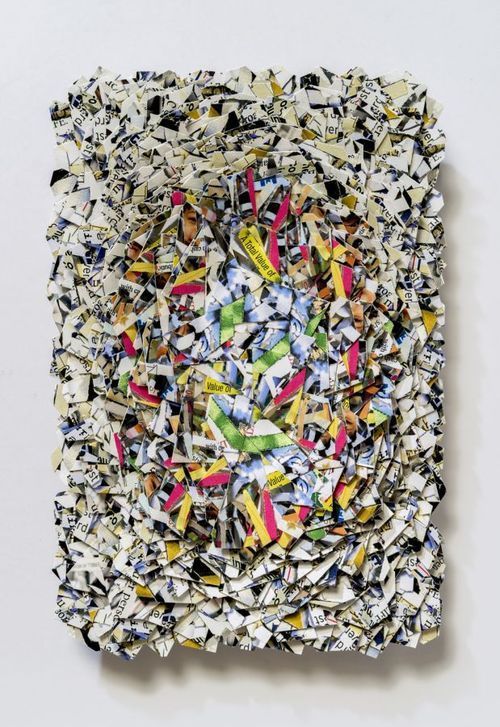
a review of Miki Baird's solo show, read this, at Haw Contemporary.
Whether manifest as a recursively-structured, digitally-printed pattern-ream, manically dense nests of collage, or a repository, organic mound, the many pieces that fill the space of Read This are unified by their materiality and their evocation of a peculiar state of consciousness. All composed in some way from overwhelming amounts of shredded junk mail, the works on display exist simultaneously as bold constructions and delicate ephemera.
Let’s just get the messy part out of the way, because there are so many interesting points I want to discuss about this work, but I can’t let it go unsaid that the piece after which the show is titled, read this fragments, bugged the hell out of me. Each in their own oversized frame, the clipped-out words ‘read‘ and ‘this’ sit like a didactic, overvalued map key ($550 for a quippy instructable? You’ve gotta be fuckin’ kidding me)–or at least so I thought at first. But when I investigated this impression a little further, I quickly realized how off-base I had been. For one, none of the text really means anything. It’s all consumer-culture detritus, full of ‘limited time offer’s that found their way here instead of to the recycling bin. Whereas usually the text at an art exhibition sheds light on the work, here the opposite is true. So what does Baird mean when she tells us so literally to read this?
Well, what does it mean to read anything? Reading is pattern recognition. It is the hyper-speed addition and decryption of series of symbolic data-points into meaning that occurs so fluidly and consistently in our lives that we usually don’t even realize we’re doing it. And when we do read with intention, whether philosophy or fiction or news or art-reviews, a necessary and inevitable part of the process is that the words on the page dissolve. They become a proxy to vicariously engage the imaginative arena of consciousness in which we are not present in our physical state but rather somewhere/something else.
But if we further consider reading as something larger and more abstract than the interpretation of written language, then Baird’s invitation gets much more interesting. Scientists read electromagnetic frequencies from other solar systems to understand our universe. Hunters read anomalies in their environment to know where to look for prey. Airport security reads body language and facial expressions to anticipate threats to national security. And art critics read the visual languages presented to them to ponder stimulating thoughts. All of the ‘texts’ read by these various specialists consist of closed systems that necessitate their own corresponding interpretive logic, and once ‘-literacy’ is acquired through pattern-observation, patience, and attention to subtle detail, a richer sense of understanding the world is inevitably achieved.
At first this exhibition appears to be commenting on consumer culture and ecological crises. A closer look yields a wildly more interesting premise.
As soon as you turn the corner into Haw’s space, you are confronted with the chronicles, a waist-high, undulating pile of loose shredded adverts, large enough to be hiding one or two adults underneath. The order of the piling of this bulbous form found far more colored paper poured over the top and backside, while the assumed front is composed of far more white confetti. Perhaps conditioned by the opening night’s coinciding with the recent Philippines disaster, the wide, dynamically cresting shape thus calls to mind a frozen, breaking wave. Not ready to pounce like a Hokusai, but rolling in as a steady, inescapable tide. Here the sideways go-green undertones are most explicit, as this collection of strips isn’t frozen behind a frame, so it stays closer to being trash. Even though Haw’s high ceilings slightly diminish the impact of the scale, when you really think about how many hundreds or thousands or more of printed pages were shredded to create this installation, it produces some anxiety. The tidal wave of information is overwhelming. The only way to process what’s before us is to consider it as its sum instead of its parts.
The lefthand path around Baird’s wave leads to another anomalous piece of the show (almost all the others are uniformly scaled, variegated products of a series called read this series from the chronicles). I instantly nicknamed the lone vertical digital print the seizure tapestry. Let me explain: One time, I believe I experienced the precursive aura of a seizure. I was sitting up on my couch and suddenly there began this noise that sounded incredibly distant and close at once, like a combination between an ear-bound mosquito and a rumbling train. As the mechanical and bubbly whine intensified, my vision began to distort. Colors started separating into sharp, staticky strips of reds and greens, interlaced like a TV filmed in slo-mo, grating against each other as they pulled further and further apart. I felt like my brain was being pulled in half, but not into two clean parts. Rather, it was like alternating fibrous connectors being torn like a complexly woven sweater. The experience is burned into the retinas of my memory because it was so unique, and honestly terrifyingly intense.
Baird’s print might be the first time that something in the real world has reminded me of the aesthetics of that perceptual malfunction. Indeed, question #7 (the real name for the seizure tapestry) is doing something very similar. Whenever a seizure or mental illness or high dose of psychedelics throw us into hallucination, they scramble the way our cognitive faculties would normally interpret the raw information soaking into our brain through our senses. Because the way the brain operates, under any circumstance, is by locating and processing patterns, that still occurs. But the pattern that emerges is inherently not rationally ordered, so the result is an utter foreignness that can only be absorbed on aesthetic terms.
The other six pieces in the show, part of read this series from the chronicles, are assembled seemingly from many iterations of a single print each, cut up here into uniquely shaped fragments that are gathered and composed into new structures. Loosely rectilinear and flat-ish, but thickly textured, these framed pieces engage in a painting dialogue–woven physically much like in the illusion created by the seizure tapestry, to the same schizoid effect. A traditional role of painting for much of art history was to show the beauty of select moments in time, preserved so that typically-less-observant people might be able to temporarily enter the artist’s lens of worldly appreciation. But when a single instant is broken to pieces and stretched out to extreme degrees, how does our awareness of it change? Finding complexity in the mundane through a sense of focus created by their radial assembly, they pull the viewer in hypnotically. Like the wave, there are so many competing pieces of equivocal information that there is no choice but to absorb the whole all at once.
I admire most about what Baird is doing here that her process of arriving at a coded totality is as meticulously ordered as a schizophrenic conspiracy theory. Like when an image on a computer glitches, it still is read by the machine as alphanumerical data, when the brain’s pattern-recognition software becomes driven by a virus of psychosis, you wind up with bizarre and complex, yet in a strange way very logical, constructions. But you don’t have to be insane to get this. If there is anything that postmodern philosophy was good for, it is instilling the question in us of whether or not there is any ‘true’ pattern out there to find. We all create our own ways of perceiving the world, in varying degrees of complexity. The meaning of Miki Baird’s, as I see it, is way the fuck out there, but like anyone who has ever enjoyed a little brain-blending knows all too well, sometimes the most fun thing you can do in life is ride the wave to the crazy conclusions it takes you.
#Experimental#review#miki baird#haw contemporary#hallucinatory#painting#collage#seizures#perception#reading#will meier#kansas city art#solo show#hallucination#typhoon#wave#pattern recognition#cognition#schizophrenia#installation#digital print#consciousness#read this#text#shredded paper#nests#nesting#tapestry#meaning#psychedelics
6 notes
·
View notes
Photo
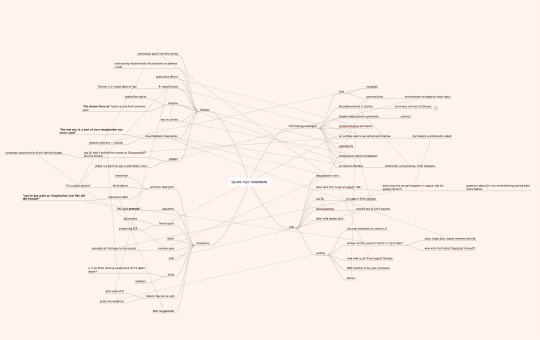
what working out a complicated thought looks like for me in-progress...
mindmap of a movie review I've been sitting on for awhile for 2013 Sundance film, Escape from Tomorrow
#mindmap#in progress#experimental#escape from tomorrow#movie review#process#sundance#disney#preliminary#will meier#tangents#connections
1 note
·
View note
Text
View of Orange (Split) from Ocean Park
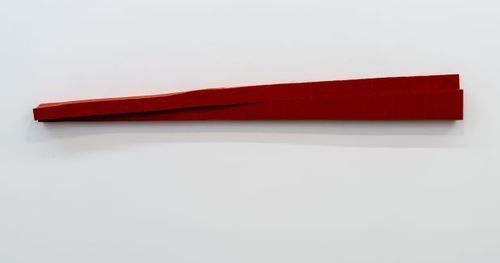
View of Orange (Split) from Ocean Park
a pseudo-review / critical thought-experiment concerning Marcie Miller Gross's work on view at Haw Contemporary through the end of 2013
As a painter, I find the wall-hung Orange (Split) highly interesting from a perspective within the historical lineage of Bay Area natural-abstractionist Richard Diebenkorn. I have written multiple times about the painter’s renowned Ocean Park series, of which I was fortunate enough to see a comprehensive, unforgettable showing in Fort Worth, TX a couple of years ago. His prolific career was largely dedicated to distilling stunning moments in vast, luminous spaces into abstractions of their essential natures, which is basically how I want to understand Orange (Split) to operate, within reasonable proximity to Gross’s own practice.
Not across the board, but largely, Ocean Park paintings are about as abstract as Diebenkorn gets, sometimes verging on the territory of colorfield AbEx-ers like Mark Rothko for their almost entirely nonobjective compositions. Given the character of the painter’s signature linework of negative-space fissures produced by nearly-abutting sheer planes of chroma, his paintings rumble with a sort of energy that I can only describe as tectonic. The compressed tension existing between Diebenkorn’s chromatically vibrating surface planes often scores high points on the aesthetic richter scale.
In the case of Orange (Split), the same holds true. Instead of the chunky, angular density and arhythmic arrangement seen in her other piece at Haw, which in shape and color feels like a swarm of PA monitors resting on the wall, Orange (Split) erupts back and forth in a lateral crackle that keeps the eyes moving in cyclical momentum that functions beautifully within her complimentary wedge-forms. The parenthetical half of the piece’s title indicates that Gross, too, is most interested in the high-pressure hollow between her solids.
Whereas Diebenkorn’s landscapes most often depict the undulating, hilly, coastal San-Fran’ region, often in ‘portrait’ orientation due to the bird’s-eye verticality of looking down on a landscape, Gross’s Orange (Split) makes perfect sense in its sideswiping gesture, given the general sprawling flatness of the midwestern plains. For this exhibition to debut at a time of year just as leaves everywhere begin to coat the ground with their deep auburns and crimsons, at a time of day just as the sun sets, the reddish horizon-line of Orange (Split) seems to have a more interesting dialogue with what is outside the adjacent windows than what hangs on the wall across the room.
How can you avoid the conversation of landscape painting with a wall-hung piece in a 9:1 aspect ratio that signifies very literally as strips of space stacked atop one another? And just as her compositional decisions here hint toward the natural world, Gross’s process of layering thin pieces of felt, using a near-flat material in accretion to arrive at dimensionality certainly speaks to a painterly mindset. Sure, the piece is dimensional, almost as deep as it is high, but look at the edges. They are flat as can be, as neutral and affectless against the frontal plane as the edges of a canvas.
On her website, Gross uses the sumptuous word ‘architectonic’ multiple times to describe her aesthetic concerns. I feel that this is highly appropriate terminology with regards to Orange (Split). Much of her bio otherwise addresses hot-topic formal concerns of materiality and site-specific context, a far drier take on the potential of her forms than I have presented here. But if it comes down to it, I would rather make a stretch to believe that we are given a slice of landscape, an abstraction of universal autumnal phenomena in the form of a highly reduced physical gesture, than simply an analytical response to the Haw Contemporary foyer. If I am completely off-base with this one, then I would say, sorry, but Orange (Split) just lost my interest.
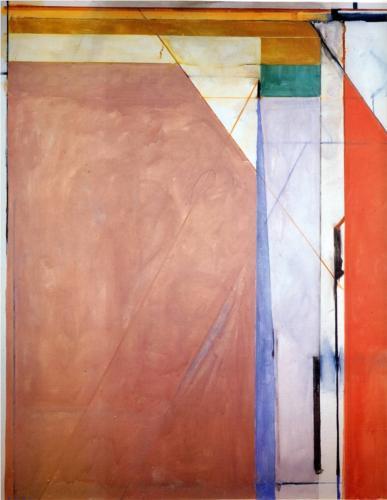
#review#critique#hybrid style#experimental#marcie miller gross#haw contemporary#diebenkorn#painting#sculpture#landscape#will meier#kansas city art#site-specific#abstract expressionism#bay area painting#architectonic#solo show#ocean park
0 notes